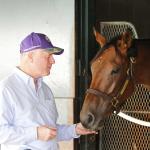
Betting on Speed in the 2025 Gun Runner Stakes

At the end of the 19th Century, Col. Edward Riley Bradley — a self-proclaimed gambler, bookmaker, and owner/manager of several casinos — was informed by his doctor that a more outdoor lifestyle might be beneficial to his health.
Something as simple as taking walks or hikes might have done the trick, but this was much too slow-paced for Bradley. In his mind, the most sensible thing to do was start a racing stable, where he could benefit from outdoor living while simultaneously building an empire in a sport deeply intertwined with gambling. What a picture-perfect scenario!
Born on Dec. 12, 1859, Colonel Bradley wasn’t really a colonel. Although he partook in many different enterprises and activities during his younger days, military life was not among them. The “colonel” part of his name was actually an honorary title; he was a classic “Kentucky Colonel.” Thanks to his achievements in horse racing, he soon became a Kentucky legend.
Having made the decision to delve into horse racing, Bradley — like many other successful sportsmen of the time — wasted little time buying up talented horses, hundreds of acres of land, and some quality broodmares to establish a racing stable and breeding farm. Forty years later, he had irrevocably changed the sport of horse racing for the better, and the legacy of his breeding farm extends to this day.
Under the name of Idle Hour Stock Farm, Bradley bred more than 125 stakes winners from 1906 through 1946, but it was the quality of these horses — and the quality of one broodmare in particular — that had a lasting impact on the sport.
PRIME CORNELIA AND BRADLEY

Courtesy of Keeneland Library /Cook Collection
One of the first successful horses that Bradley raced was a tough-as-nails gelding by the name of Bad News. As a result of that success, Bradley began the tradition of only choosing names that began with the letter “B” for his horses. One would have thought that Bradley would eventually run out of names, but this was far from the case — while he did eventually have to use names like Bee Mac, Bric a Bac, Bymeabond, Bug Juice, and Bee Ann Mac, his creativity ensured that he never ran out of names. As a side effect, all of the best horses he ever bred and raced had “B” names. These included Bimelech, an unbeaten champion 2-year-old that later won the Preakness and Belmont; Blue Larkspur, who won four of six starts in 1929 en route to being recognized as Horse of the Year; and Busher, who beat colts with frequency to become one of only 12 fillies or mares that have been recognized as a U.S. Horse of the Year.
Some of Bradley’s greatest successes came in the Kentucky Derby, a race that he dominated in the 1920s and 1930s. He won the race four times during that time frame, and — incredibly — his horses swept the first two finishing positions on two occasions. Interestingly, the best-remembered of Bradley’s Derby winners was the least accomplished as a racehorse: Brokers Tip won just one race in 14 career starts, but had the good sense to make it count by scoring a nose victory in the 1933 Kentucky Derby. Even still, it’s likely that he would be long forgotten if not for the fact that his jockey and the jockey of runner-up Head Play engaged in a fight down the homestretch in which they grabbed each other’s silks and boots and even struck at each other as they battled for command of the race. Brokers Tip crossed the wire in front, and after an inquiry, the results were left as posted.
BRADLEY AND JAMES BUTLER, 1930

Courtesy of Keeneland Library /Cook Collection
But as mentioned above, Bradley’s greatest impact on the sport would come through one broodmare. At the end of 1930, Bradley purchased a 4-year-old filly by the name of La Troienne from a sale in Europe. As a racehorse, she had failed to win in six starts, but the daughter of Teddy had a quality pedigree that suggested she could be a valuable broodmare. In the end, she proved to be much more than that. She produced five stakes winners that included the Bradley champions Black Helen and Bimelech, but her daughters proved to be even more successful, and founded an epic, wide-spreading family of descendants that includes Affectionately, Buckpasser, Mineshaft, More Than Ready, Princess Rooney, and Smarty Jones.
Bradley passed away in 1946, and the majority of his horses were purchased by fellow racehorse breeders John Hay Whitney, Robert Kleberg, Jr., and Ogden Phipps, who extended the legacy of Bradley’s empire by breeding many champions of their own from his quality stock. To this day, breeders and racing fans alike still value the descendants of Bradley’s horses, particularly those that descend from La Troienne. His farm may be gone, but Bradley’s legacy lives on.
Fun Facts